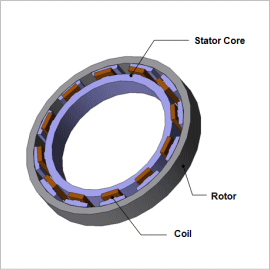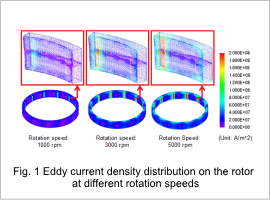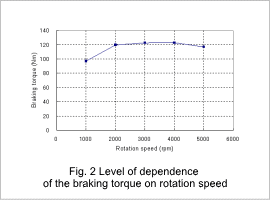*Please prepare a license ID and password for the license administrator.
*It is different from the service for JMAG WEB MEMBER (free membership). Please be careful.
Overview

An electromagnetic brake is an auxiliary brake device for large-scale vehicles like trucks and buses. It is fit onto the propeller shaft and applies a braking force. There are both hydraulic and electromagnetic types. With an electromagnetic brake, a magnetic field is produced in the stator coil, making eddy currents occur because of time variations in the magnetic flux density linking to the rotor. This, in turn, produces a braking torque. The range in which eddy currents occur in the rotor and the braking torque can vary a great deal according to the current flowing to the stator coil and the rotor’s rotation speed.
In order to estimate the electromagnetic brake’s performance accurately at the design stage, it is best to carry out an electromagnetic field analysis simulation using the finite element method (FEM) because it can approximate the material’s nonlinear magnetic properties and can approximate the skin effect caused by current distribution, as well.
This Application Note shows how to obtain the braking torque of an electromagnetic brake during drive.
In order to estimate the electromagnetic brake’s performance accurately at the design stage, it is best to carry out an electromagnetic field analysis simulation using the finite element method (FEM) because it can approximate the material’s nonlinear magnetic properties and can approximate the skin effect caused by current distribution, as well.
This Application Note shows how to obtain the braking torque of an electromagnetic brake during drive.
Eddy Current Density Distribution

Fig. 1 shows the eddy current density distribution of the rotor at different rotation speeds. Eddy currents flow on the inner surface of the rotor to interrupt the magnetic flux produced by the stator coil. When the rotation speed increases, the magnetic flux flowing in the rotor changes substantially, thereby increasing the eddy currents generated on the rotor.
Dependency of Braking Torque on Rotation Speed

Fig. 2 shows the level of dependence of the braking torque on rotation speed.
When the rotation speed increases, eddy currents are concentrated on the surface due to the skin effect, making the electric resistance grow larger and shrinking the amount that the eddy currents increase. As a result, increases in the braking torque also become smaller because it is caused by eddy currents.
When the rotation speed increases, eddy currents are concentrated on the surface due to the skin effect, making the electric resistance grow larger and shrinking the amount that the eddy currents increase. As a result, increases in the braking torque also become smaller because it is caused by eddy currents.


